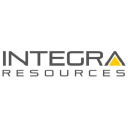Integra Resources: Three-Project Strategy Targets Quarter Million Ounces of Gold

Integra Resources acquired producing Florida Canyon mine, pursuing fully-funded growth to 250kozpa. DeLamar feasibility & permits next, Nevada North follows.
- Integra Resources acquired the producing Florida Canyon mine in Nevada to complement its development projects in Idaho and Nevada
- Florida Canyon currently produces 70,000 oz gold per year with a 7-year mine life, with potential to optimize and extend
- Integra plans to grow production to 250,000 oz per year by sequencing Florida Canyon, DeLamar in Idaho, and Nevada North
- DeLamar feasibility study is underway with permitting planned for 2025-2027 to enable construction
- The acquisitions makes Integra a self-funding growth company not reliant on equity markets to advance its projects
Integra Resources is emerging as an exciting growth story in the gold sector after acquiring the producing Florida Canyon mine in Nevada. The acquisition transforms Integra into a gold producer and provides a platform for growth to over 250,000 ounces per year by sequencing its DeLamar project in Idaho and Nevada North. With a resource base of over 10 million ounces and a pipeline of near-term catalysts, Integra offers a potent opportunity for gold investors.
Interview with CEO Jason Kosec
Florida Canyon: A Springboard for Growth
The recently acquired Florida Canyon mine currently produces about 70,000 ounces of gold per year from oxide ores and has a 7-year reserve life. Integra CEO Jason Kosec sees strong potential to optimize the operation and extend the mine life, stating:
"...the beauty about this asset is it's 40 minutes from our Nevada North project and two and a half hours from our DeLamar project, so it creates this regional mining platform."
Integra plans to invest $3.5 million at Florida Canyon in 2025 on optimization studies and infill drilling aimed at improving mining rates, recoveries and costs. According to Kosec:
"...there's a number of things we're looking at in terms of overall slope angles, short hauls to increase cycle times, fragmentation, all with potential to increase production and lower costs."
While 2025 production is forecast at 70-75,000 ounces, an updated technical report and 3-year guidance are planned for early 2026.
DeLamar: The Next Leg of Growth
As Integra optimizes Florida Canyon, the focus will shift to advancing the DeLamar project in Idaho as the next leg of growth. A feasibility study is underway incorporating an additional 42 million tons of stockpiled oxide ore which is expected to increase annual production to 135-140,000 ounces and extend the mine life by about three years.
Integra is updating DeLamar's mine plan to reflect the feasibility study results ahead of launching the permitting process. According to Kosec,
"...the idea is to have our notice of intent signed by the end of 2025,... which under the new regulations puts us under a two-year shot clock."
While DeLamar has been perceived as challenging from a permitting perspective, Kosec believes it is more straightforward than other Idaho projects.
"This is a restart of a brownfield site, there's no major waterways, no Forest Service land, no endangered fish. It's been a mining town since the 1800s."
Nevada North Provides Optionality
Looking further ahead, Integra's Nevada North project provides additional production growth potential. While earlier stage, Kosec noted that :
"80% of the ounces are in measured and indicated with an 87-90% conversion rate, so it's not a typical PEA."
Additionally, the project could be permitted within 6 months in Nevada. As spending on DeLamar declines, Integra plans to advance long-lead items for Nevada North to submit a mine plan of operations.
A Self-Funded Growth Profile
Importantly, the Florida Canyon acquisition allows Integra to self-fund its growth to over 250,000 ounces per year, removing a key overhang for the stock.
"The building blocks are frankly in place to go from 70,000 to 250,000 ounces per annum over the coming years, and really most of it being funded out of cash flow. This separates us from the developer peer group that always has to constantly go to market to raise money - we don't envision doing that."
The Investment Thesis for Integra Resources:
- Exposure to a growing mid-tier gold producer with 10+ million ounces and a path to 250,000 ounces per year
- Fully funded organic growth from acquired Florida Canyon cash flows, not reliant on equity markets
- Near-term optimization and expansion potential at Florida Canyon to enhance production and mine life
- Upcoming DeLamar feasibility study and permitting catalysts in a historic Idaho mining district
- Longer-term growth optionality from Nevada North with potential for quick permitting
- Proven management team with a track record of accretive M&A and project delivery
- Attractive valuation at 0.22x P/NAV with significant NAV growth potential as project pipeline is advanced
Macro Thematic Analysis:
The gold price has shown significant rise in 2024, trading around $2,600/oz as the market weighs the outlook for interest rates and the global economy. Many analysts believe gold is in a long-term bull market, driven by persistently high inflation, elevated geopolitical risks, and rising demand from central banks.
In this environment, gold equities have been attracting increased investor interest. Producers that can demonstrate fully funded organic growth pipelines to increase scale tend to command premium valuations. As Integra Resources CEO Jason Kosec highlighted:
"...the reason developers trade at 0.1-0.2x NAV is because everyone knows you're coming to the market for $10-15 million each year. Removing that financing overhang allows us to rerate in line with producing peers at 0.4-0.6x."
With its self-funded growth to mid-tier scale, upcoming catalysts, and discounted valuation, Integra appears well positioned to benefit from the positive gold macro backdrop. Kosec summarized the opportunity:
"The building blocks are in place to unlock over a billion dollars of NAV at $2000 gold as we sequence our projects to grow to over 250,000 ounces per year."
Analyst's Notes




Subscribe to Our Channel
Stay Informed



































